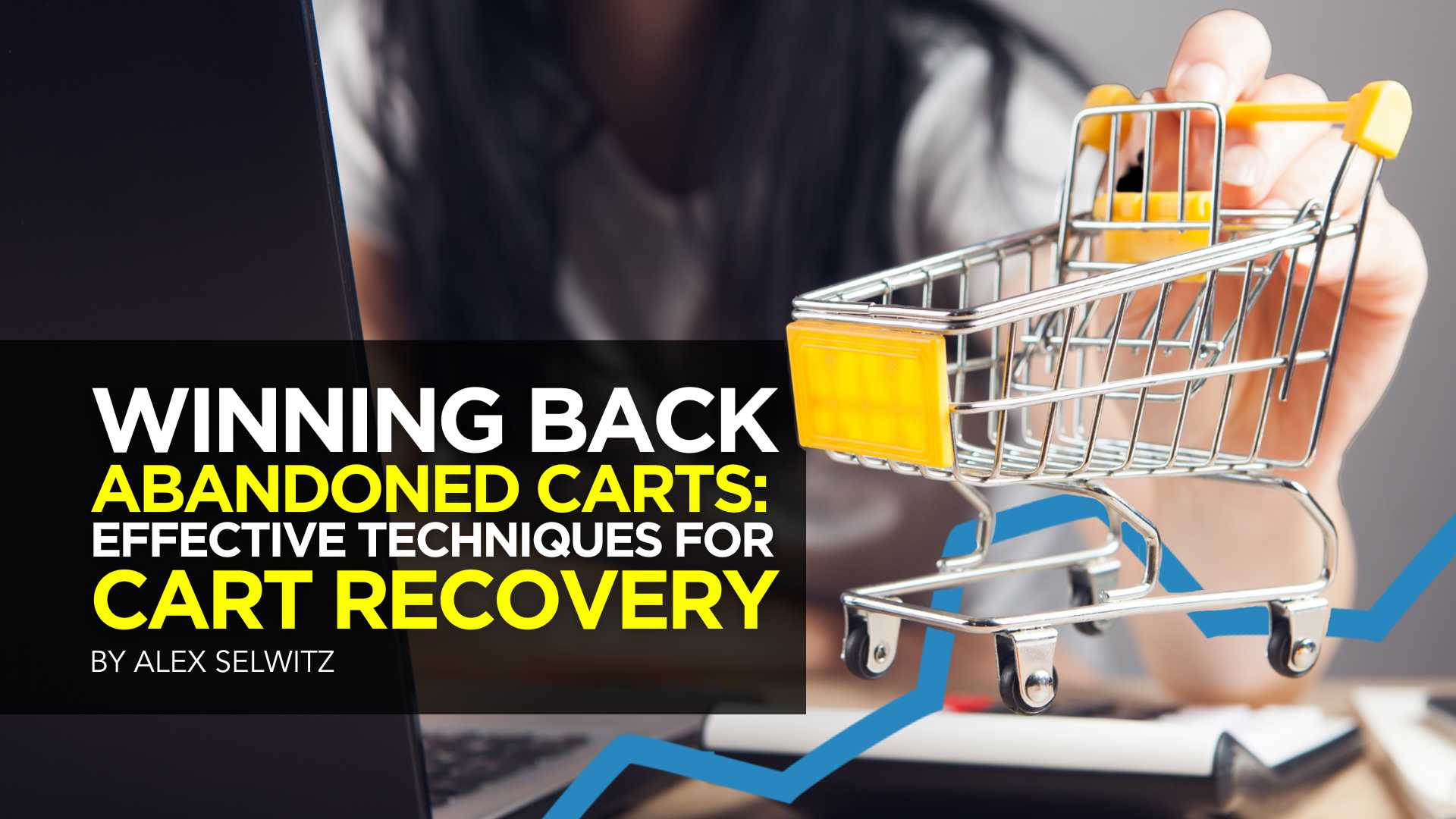Winning Back Abandoned Carts: Effective Techniques for Cart Recovery
- September 27, 2023
- Knowledge Base
- 0 Comments



A solitary abandoned cart might seem inconsequential in the bustling digital bazaar that is the eCommerce of today. Yet, when looked at collectively, these unclaimed carts represent a staggering amount of potential revenue slipping away.
What causes a customer, eager to purchase, to suddenly change course? The list of reasons might be endless, but the most common are:
- High shipping costs or long delivery times: rapid and affordable deliveries are the expectation, not the luxury.
- Complex checkout process: a labyrinthine checkout can deter even the most enthusiastic buyer.
- Security concerns: with the world rife with cyber threats, customers need to be assured of their data’s safety.
- Limited payment options: a restricted choice can mean a lost sale, as customers have varied payment preferences.
- Website errors or slow load times: a seamless online experience is paramount; glitches can quickly divert potential sales elsewhere.
The real question, though, is how can businesses address these issues and win back these customers?
The path to resolution is multifaceted, yet incredibly rewarding for those willing to invest the effort. As we dive in, we will explore proven techniques and considerations that not only tackle the root causes of cart abandonment but also provide strategies to reclaim potential revenue.
Proven Techniques for Cart Recovery
The task of addressing cart abandonment is akin to a surgeon wielding a scalpel: precise, calculated, and aiming for effective results. While recognizing the root of the problem is paramount, the real magic unfolds when businesses deploy actionable solutions.
These tried-and-true techniques are not merely strategies but powerful tools that can significantly transform the landscape of eCommerce. They don’t only help retrieve lost opportunities but also fortify their brand’s digital presence.



Become A Certified E-Commerce Marketing Master
The Industry’s Most Comprehensive E-Commerce Marketing Certification For The Modern Marketer. Turn Products Into Profit, Browsers Into Buyers, & Past Purchasers Into Life-Long Customers.
These proactive solutions are some tried-and-true techniques:
Personalized Email Campaigns
In the vast sea of the digital realm, personalized emails act as lighthouses, guiding customers back to their intended purchases. Generic emails easily drown in the cacophony, but those tailored to an individual’s preferences stand out, signaling care and attention. Here’s a short how-to:
- Craft tailored content — beyond just mentioning the product left behind, consider integrating aspects of their browsing behavior. Perhaps they looked at a specific category multiple times? Highlighting products from this category can remind them of their initial interest. If they’ve been a repeat visitor or customer, reference their loyalty, maybe even offering them an exclusive deal as a token of appreciation.
- Behavior-triggered reminders — timing is crucial. Sending an email too soon can feel pushy, while waiting too long might mean they’ve lost interest or found an alternative. Optimal timing, often within a few hours to a day, can be the sweet spot. Moreover, making these reminders interactive, perhaps with engaging visuals of the product or an enticing call to action, can further the chances of re-engagement.
- Segmentation mastery — beyond just past purchases, consider segmenting based on how they’ve interacted with your site. Did they read blog posts? Watch videos? Use this information to craft messages that speak directly to their engagement style and preferences.


Time-Sensitive Incentives
The ticking clock of time-sensitive incentives can often be the gentle push customers need to complete a purchase. However, the intricacy of implementing them demands a nuanced approach. The basics include:
- Varied incentives — a diverse range of customers means a variety of preferences. Some are motivated by direct price reductions, while others find value in added benefits. For instance, a discount might appeal to bargain hunters, but a complementary product could entice those looking for added value. Offering loyalty points can be especially effective for repeat customers, making them feel their loyalty is being rewarded. Regularly rotating these incentives and monitoring which ones drive the most conversions can help fine-tune your strategy.
- Strategic timing — beyond just the time of day, consider the customer’s journey. For instance, if they’ve visited the product page multiple times over a week, this might be an indication of high interest but some reservation. A timely incentive, presented during their next visit, could be the catalyst for conversion. Seasonal offers, during holidays or special occasions, can also drive up sales, tapping into the festive purchasing mindset.
- Balancing urgency and pressure — the language of urgency is delicate. While “Only a few left!” can motivate, overuse can lead to skepticism. Authenticity is key. If you’re offering a limited-time discount, maybe provide a brief reason, such as clearing out end-of-season stock, giving customers a rationale they can appreciate.


Engaging Retargeting Ads
The digital space is filled with distractions, and retargeting ads serve as persistent reminders, guiding potential buyers back to their initial interests. Here’s the 101 for retargeting:
- Platform-specific content — dive deeper into the analytics of each platform. For example, Instagram, being visually dominant, might benefit from high-quality images or short videos of the product in use. LinkedIn, with its professional audience, might resonate more with B2B products or services, emphasizing efficiency and value-addition.
- Narrative — building on the idea of storytelling, consider creating a series of retargeting ads that narrate a journey. Begin with reintroducing the product, followed by showcasing its benefits, and culminate in presenting a compelling offer. Customer testimonials, expert endorsements, or even showcasing the product’s origin story can add layers of depth and trustworthiness.
- Budget allocation and ROI — diversify your retargeting budget. While it’s tempting to heavily invest in platforms where most of your audience resides, don’t overlook emerging platforms or ones where competition might be lower. Regularly reviewing metrics like click-through rates, conversion rates, and overall ROI ensures you’re getting the best bang for your buck. Adjusting your strategy based on these insights can result in more effective campaigns.
Optimizing the Checkout Process
The final frontier in the buying journey, the checkout process, demands meticulous attention. Any friction here can swiftly turn a potential sale into a missed opportunity. What you don’t want to miss out on is:
- Intuitive design — elevate the user experience. Incorporate visually pleasing elements like icons that denote each step, or even progress bars to give users a sense of how close they are to completion. Real-time validation, where form errors are highlighted immediately rather than after submission, can prevent user frustration and streamline the process.
- Reducing drop-off points — implement feedback loops. If a user does abandon their cart, consider prompt surveys or pop-ups asking why they chose not to proceed. This direct feedback can be invaluable in identifying and rectifying friction points. Also, offer multiple payment gateways. Some users might prefer direct card payments, while others might lean towards digital wallets or even cash on delivery, depending on your region.
- Mobile-first design — the rise of m-commerce (mobile commerce) demands an impeccable mobile experience. Beyond the basics, incorporate features like digital wallet integration for faster checkouts, image zoom functionalities for better product viewing, and quick customer support access, such as chatbots or live chat, ensuring any last-minute queries or concerns are promptly addressed.
Additional Considerations: User Trust, Delivery Concerns
Beyond the primary strategies lie nuanced layers of consideration that, while subtle, can significantly influence a customer’s buying journey. These are often the finer details that a business might overlook in the broader eCommerce strategy.
However, when addressed with care, they can provide the extra push needed to convert a tentative cart into a confirmed purchase. Here are the most common ones:


- Exit-intent pop-ups: These are last-minute saviors. Just as a user is about to leave the site, an attention-grabbing pop-up can present an offer or remind them of their abandoned cart. For maximum impact, the content should be compelling, the design eye-catching, and the offer genuinely valuable.
- Cart recovery emails: More than just a reminder, these emails serve as a bridge. They can offer insights into what the user might be missing out on, present additional incentives, or provide assurance regarding any concerns the user might have had. Crucially, the timing and frequency of these emails should be optimized — too soon might seem pushy, too late and they might’ve lost interest.
- Social proof: Trust is a currency in the digital marketplace. Showcasing genuine customer reviews, testimonials, or ratings can instill confidence in potential buyers. Additionally, displaying trust badges or security certifications assures customers that their data and transactions are safe.
- Highlighting seamless delivery options: For many, the uncertainty of delivery times and options can be a deterrent. Clearly presenting diverse delivery choices, estimated times, and any associated costs can alleviate these concerns, making customers more comfortable with completing their purchase.
- Advantages of partnering with 3pl companies: Efficient and reliable order fulfillment can make or break the post-purchase experience. Do your homework and find out what is a 3PL — third-party logistics companies can offer better delivery timelines, track packages more accurately, and boost overall customer confidence in the brand.
The beauty of these additional techniques lies in their ability to address the more intricate concerns of customers. While the core strategies tackle broader issues that lead to cart abandonment, these supplementary methods cater to the finer points of the shopping experience.



Become A Certified E-Commerce Marketing Master
The Industry’s Most Comprehensive E-Commerce Marketing Certification For The Modern Marketer. Turn Products Into Profit, Browsers Into Buyers, & Past Purchasers Into Life-Long Customers.
They speak to the subtleties of trust-building, reassurance, and personalized engagement. Together, these refined touches, combined with the foundational techniques, create a holistic approach to counteracting cart abandonment and maximizing e-commerce potential.
Takeaways
Navigating the challenges of cart abandonment is akin to piecing together a jigsaw puzzle. Each solution is a vital piece that, when placed correctly, completes the picture of a successful eCommerce venture.
Addressing cart abandonment is not just about reclaiming lost sales; it’s about understanding and catering to the evolving needs and concerns of the modern shopper. It’s also essential to remember that the digital landscape is ever-evolving — as technology advances and consumer behaviors shift, businesses must remain agile.
Continual testing, adaptation, and learning are crucial. Every interaction, feedback, and metric can offer insights that, when acted upon, can refine and enhance the shopping experience.
The journey to countering cart abandonment may be intricate and demanding, but the rewards — in terms of both revenue and customer loyalty — are well worth the effort. Businesses equipped with knowledge, determination, and a proactive mindset are poised to turn challenges into opportunities and abandoned carts into flourishing sales.




